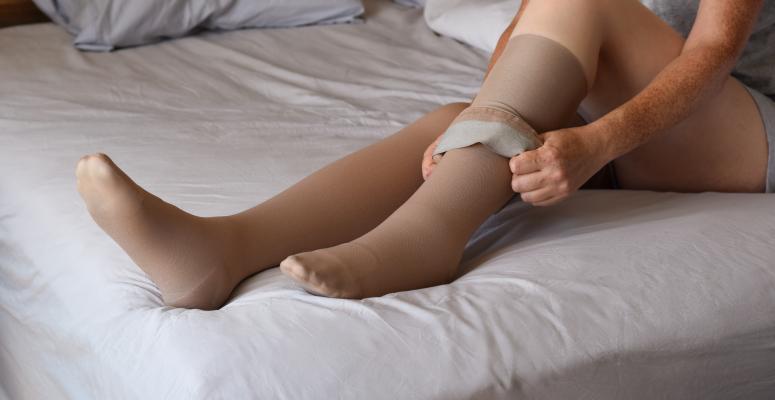
The condition of lymphedema, and related lymphatic diseases, affect millions of people around the world, with up to 10 million cases being diagnosed in the United States.
Lymphedema, also referred to as lymphatic obstruction, is a condition that causes significant swelling in an arm or leg. This can make it difficult to carry out day-to-day responsibilities due to reduced mobility. As swelling normally means that compression is the proper treatment, you might be wondering if compression socks are the right choice for decreasing lymphedema symptoms. And that’s what we’re here to answer.=
Symptoms of lymphedema
Lymphedema is the result of a blockage in the lymphatic system, which is part of the circulatory and immune systems. It causes tissue to swell from a buildup of protein-rich fluid that isn’t being flushed out through the lymphatic system.
Symptoms of lymphedema include:
- Swelling in the arm or leg.
- Restricted range of motion.
- Heaviness or tightness in the affected limb.
- Recurring infections.
- Fibrosis (hardening or thickening of the skin).
Possible causes of lymphedema
Lymphedema is usually caused by damage to the lymph nodes, often inflicted by cancer and cancer treatments. This refers to radiation as well as lymph node removal surgery that can determine if the cancer has spread.
Threadlike worms in third-world countries can also cause the condition if the parasite clogs the lymph nodes.
There are several factors that can increase the risk of being diagnosed with lymphedema, such as:
- Rheumatoid or psoriatic arthritis.
- Obesity or excess weight.
- Older age.
5 benefits of using compression socks to treat lymphedema
Unfortunately, there is no cure for lymphedema, but there are treatment options to help reduce swelling. Proper compression equipment and garments are commonly used to help with lymph fluid drainage.
A great example of effective garments for lymphedema is compression socks. Be sure to keep in mind that compression socks are different from compression stockings. While socks only cover up to your ankles, stockings can go as high up as your thigh. Your doctor can recommend which is preferable based on the areas of swelling in your leg.
While compression socks are most commonly used to reduce swelling from lymphedema, they have other benefits too.
Five ways that compression socks can help lymphedema are:
- Diminishing swelling.
- Improving lymphatic drainage.
- Boosting circulation.
- Supporting veins.
- Preventing blood from pooling in your leg.
Other compression options for lymphedema
Socks aren’t the only thing that can provide your legs with the compression needed to reduce the swelling from lymphedema. There are several types of compression options that you can explore.
There is the option of sequential pneumatic compression. This is a sleeve that can go onto your leg or arm that connects to a pump. The pump will sporadically inflate the sleeve, which will put pressure on the swollen limb and encourage the fluid away from your fingers or toes.
Your doctor may also recommend compression bandages. These are low-stretch bandages that wrap around the affected limb to redirect lymph fluid back to the trunk of your body.
Physical therapy options for lymphedema
Even though compression socks and equipment are recommended to reduce swelling caused by lymphedema, there are other ways to alleviate the symptoms. For example, physical therapy can be highly beneficial for people living with lymphedema.
One of the key ways that a physical therapist can help is by manually assisting with the lymphatic drainage. By applying light pressure using a massagelike technique, they can move the fluid from the limb to a different area of the body that has working vessels. This is a safe technique unless you have a blood clot, cancer or a skin infection.
Your physical therapist can also walk you through exercises that will allow you to contract your muscles as a way to get rid of the fluid. A few exercises that have been known to help with leg lymphedema include marching, hip rotations and heel raises.
Your physical therapist may also recommend specific types of exercising to get your legs moving, such as biking or swimming.
Alliance PTP is ready to help you find top-notch PT for lymphedema
At Alliance Physical Therapy Partners, we’re proudly bringing together physical therapy practices across the country to help people get the high-quality PT they need.
Want to see a physical therapist in person? We can put you in touch with an Alliance PTP partner that’s close to you and that can treat your lymphedema.
Not keen on in-person PT sessions or not close to an Alliance PTP partner? No worries. We also offer effective and affordable virtual physical therapy through our Agile Virtual Physical Therapy platform.
Come find help for your injury or chronic condition today!
Get Help at a Location Near You
